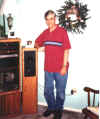
For construction details and current progress go to: Construction Details

For construction details and current progress go to: Construction Details
After completing the "Straight Pipes", I started contemplating my next project. I am quite happy with the Straight Pipes. I've been using them for six months or so as mains for both music and HT. I do wish that they would go a little lower, and they could be a little more dynamic, since a 5 1/4" driver with a 2mm Xmax only gets so loud. I considered two approaches: A larger full-ranger, such as the Fostex FE164, or a two-way. Martin King did the Fostex thing, and I didn't want to just copy his project. Also, I wanted to try my hand at a series cross-over, since I had no practical experience. Therefore my initial specification became:
>For a tweeter, my first choice was the new Vifa XT25TG. However, I couldn't justify the price for this project, particularly since I probably can no longer hear the difference. Looking at the budget tweeters, I chose the relatively unknown Peerless 811815. This driver is used in some kilo-buck commercial speakers, so I decided to chance it, giving me an all Peerless speaker.
I ordered the drivers, and upon arrival, I ran a quick parameters check. To my horror, the actual T/S parameters were miles away from the published specs. So I ordered two more 850122's. When they arrived, I broke each driver in for 12 hours at 20hz. One was an outlier, but the other three were pretty close. The actual T/S parameters for the current production 850122's are:
| Parameter | Published | Measured |
| fs | 37.7 | 56.8 |
| Vas | 27.7 | 15.5 |
| Qm | 2.29 | 3.55 |
| Qe | .55 | .495 |
| Qts | .44 | .436 |
At the very least, the new production has a different spider. Who knows what else.
I reran the simulations with the new numbers. Fortunately, the new production 850122's still work in pipes. I would not have chosen these driver if I had known what I was going to get, but in the end, the choice still looks good.
Pipe geometry:
I originally wanted to do a ML TQWT. However, while playing around with simulations, I found a better answer. The FR plot for a ML TQWT looks like:

An end-loaded TL, however, with areas of 4*Sd at the driver and 0.5*Sd at the port gives this FR plot:

Instead of a peak at cut-off, which can be slightly boomy, the TL has a gentle roll-off. This does two things. It tends to compliment room lift and it has better transient response. I decided to go with the TL.
Driver Placement and Edge Shape
Driver placement on the baffle and the baffle edge shape will have a large effect on the diffraction performance of the drivers. I ran a number of simulations using Paul Verdone's "Baffle Diffraction Simulator" spreadsheet. First, here is the simulation with the 850122 placed symmetrically at the top of the baffle (The 850122 is magenta, the 811815 is cyan. The legend is hard to read -- the middle line is 5.00db, the major divisions are 2.5db and the minor divisions are 0.5db. The white vertical line is 1000hz.):

Pretty ugly! The tweeter can be offset laterally, but the woofer can only be moved down the baffle. doing this changes the entire internal geometry of the pipe. However moving the woofer down 3" is doable. the simulation is:

Seriously better, particularly the trough at the top of the baffle hump. Now, I had always intended to use 1.5" round-overs on this cabinet. Putting the round-overs on the sides only:

Generally, the tweeter is offset to improved the diffraction problem. Offsetting the tweet 0.75" gives:

and 1.25":

>This is the final configuration. It won't get much better than this without using a much larger baffle, quite impossible for a pipe. (Well, rounding the top also does improve the +/- 1/4db ripple, but I think I can live with that!)
Here is the result:
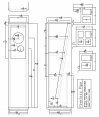
A potential builder asked me if the tweeter could be placed on top of the woofer, as he wanted the tweeter at 42". I reran the MathCAD simulation to assure that no violence is done to the pipe output, then redid the BDS simulations to find the best position for the tweeter. Here is an alternate baffle arrangement, not 42", but close. There should be no audable difference between the two baffles.
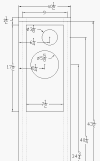
Here is the cross-over that I am using. It was modeled using Speaker Workshop. At the moment, I do not have a microphone to properly measure the results. When I get one, I will adjust the cross-over as necessary.
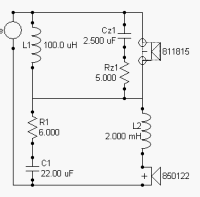
The modeled results are:
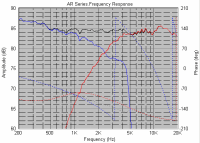
If all works right, this provides 3dB of baffle step correction, and coupled with the baffle hump shown on the BDS plot, a bit of BCC dip. It sound pretty good to me, but it may be a little layed-back for some. This entire speaker was designed to reproduce acoustic instruments, and specifically Baroque and Classical (in sensu stricto) music.
Here is the measured nearfield frequency response of the pipes. The red curve is the driver output, the blue is the port output and the black is the combined output. The first graph is the raw unstuffed pipe, the second the completed, stuffed pipe.
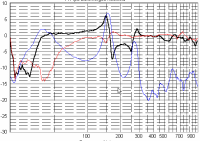
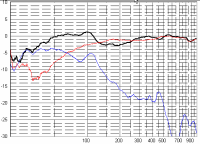
I am now required to give my subjective impression of my new creation: Very smooth. These speakers are a bit layed back, but that is a good quality for acoustic music. They go low, oh my, do they go low. 32Hz organ music is chest rattling. They cut off quickly below that, but, unless you need Saving Private Ryan at realistic levels, these speakers are more than adequate for HT. They sound very nice with full orchestra to jazz trio. Gee, I'm proud of these things!
Top